|
|
Verwood Methodist Church
Celebrating 100 Years in 2009.
|
(A lot of information in these articles comes from the 75th Methodist Church
Anniversary booklet extended by the webmaster to 2009.)
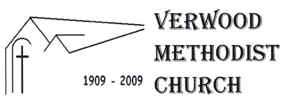
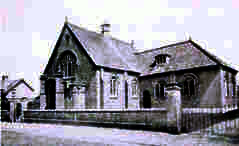
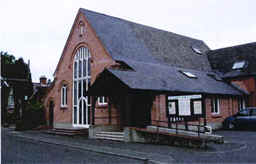
1909
to 2009
CHURCH
HISTORY
There
are references to Methodism in Verwood from the mid 19th century. The present
site was obtained in 1908 and the foundation stone laid on the 26th May 1909 and
the first service in the Church being in November 1909. The year 2009 therefore
is the centenary of Methodist Worship in this place.
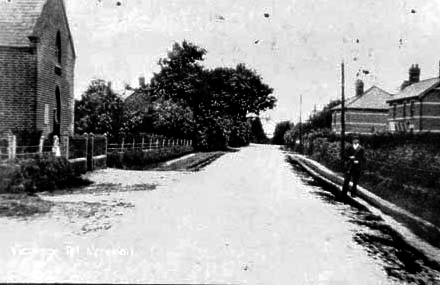
THE
VERWOOD METHODIST CHURCH PROPERTY
In
1819 an Independent Chapel was built in Verwood, but Anglicans still had to
travel to their parish Church at Cranborne. However in 1829, with a village
population of about four hundred the Anglicans built a chapel which became,
with alterations, the present Church of St Michael and All Angels. Other
buildings were erected, some of them cob-walled. Their successors are now the
United Reformed Church in Manor Road and the present Methodist Church in
Vicarage Road.
There
was a Methodist Society meeting in Verwood from some time after the middle of
the last Century, but records are so scarce that no exact dates can be found.
Reference has been found to a mud and wood building with eighty free seats, but
in 1901 there was said to be fifty seats available for letting and thirty set
apart for children, at "an overlap of fifteen inches each". The same
record states that the Wesleyan Chapel be continued from 1865.
A
small building stood on what is now the car park, on which a lease was
negotiated in 1888, but at a Trustees Meeting in 1905 it was noticed that the
lease had expired, so a new one was negotiated.
In
1876 there were no Trustees, but Mr C King was treasurer of a building valued at
£200 which was insured for three shillings. The income for the year was L1.18s.
The first time a balance in hand is recorded is 1894 - it being £1 .
After
a good deal of discussion and negotiation the site was enlarged and on November
5th the decision was taken to build. Correspondence took place with the
Methodist Chapel Committee in Manchester and a letter dated May 1905 on the
purchase of land for a new building points out that "there is no idea of
the prospect of the neighbourhood so that the secretaries cannot say what area
should be secured. A guiding principle is that you need at least seven feet for
every person to be accommodated".
The
plans were agreed on December 17th and a public meeting and tea initiated the
building scheme. Tenders were in on March 25th and Mr Hodder of Shaftesbury was
given the contract for a cost of £1015 - after the Trustees had checked his
credentials. The bricks used were supplied by a Verwood brickyard.
The
heating system was by hot water apparatus and the lighting "to be by a
newly patented system of petrol and air". The plans included
"provision for offices and stables".
One
of the deciding factors in proceeding with the work was a "donation"
of £250 from Mrs Bracher, for which the Trustees undertook to pay her 4% during
her lifetime. She was subsequently invited to lay a stone.
The
stonelaying was on May 26, 1909 when the Chairman of the District (Reverend
Josiah Mee) presided and the Reverend Llewellyn of Ringwood spoke. Mr Fryer of
Verwood Manor, who had helped with the freehold, was invited to take the Chair
at the evening meeting. A circular was issued "setting forth the cost and
soliciting donations".
The
building was to be completed by the middle of November 1909. So it took just six
months from laying the foundations to being ready for worship.
The
Congregational friends were asked to lend the British Schoolroom for services on
October 17th and 24th. The Opening was on October 27th. The Pleasant Sunday
Afternoon (PSA) Band played selections of music and the Broomhill band led the
singing.
By
February 1910 the builder was asked to "get the vestry ready as soon as
possible and also to get the seats ready for the Choir". It was decided to
call Mr Chincher's (the architect) attention to "vacant places in the
ceiling of the church at each end.
In
the discussion of Church seating the cost of whitewood as against pinewood was
debated: pinewood was preferred. These pews continued to be used until they were
replaced during the church extension which occured during 1993 and opened in
January 1994. The Pulpit and existing pipe organ were replaced at this time, the
organ being replaced with an electronic one with large speakers on shelves high
up at the rear of the church which is in use today (2009).
At
the Annual Trustees Meeting on March 29, 1911, Mr A Hopkins, the Trust Treasurer
reported a total income of £31.11s.4d. There had been a balance of £12.4s.9d.
from the previous year. £10 was spent as interest on the f250 loan, £3.12s.11d
on lighting, cleaning and heating, 18/- for insurance, including the Chapel
Keeper, and 18/- for the organ and choir. Nothing was given to Connexionial
Funds, and all other expenses came to £3.17s.8d., with nothing to carry forward
for the following year. Mr Bollom was thanked for his efforts in money raising.
By 1914 there was a balance in hand -of £32.16s.7d.
The
pump in the copper house was out of order in February 1918 and Mr Hopkins
promised to have it repaired. This is a reminder that there was only limited
mains water in the village before 1959 and a comprehensive sewage system had to
wait until 1970. Both gas and electricity were late arrivals.
It
cost f21.11s.2d. to light and heat the buildings in 1929 and the fire insurance
was £1.17s.6d.; £10.13s.6d. was expended under the heading of "Organ and
Choir". The first Bazaar was held in December 1930 and raised £65, which
was deposited in the Bank in the names of V Thompson and Y Reeks; (did they not
have a Bank account?). That year a new boiler was fixed for £27.19s.3d.
The
petrol and air lighting seems to have been giving trouble by 1934 when a special
meeting decided to approach Mr Lyston about wiring the Church "in the event
of electricity coming to Verwood... in the meantime wiring to be done and use of
a dynamo employed at a cost of £45". By 1939 "better lavatorial
accommodation" was discussed. An auction sale was arranged to raise funds
to pay for a new gas heating system, estimated to cost approximately £500.
The
New Church Hall in current use was built and then opened in 1984 during the
tenure of the Rev. Derek R Chapman. It replaced the wooden huts which had till
then been found at the rear of the church. One of these huts found its way to
the Dewlands Park Caravan site after it was removed from the church.
During
the tenure of the Reverend Chris Blake the church itself was extensively
enlarged and redesigned extending nearer to the pavement and also to the side
taking in the original vestry. At the same time the side hall had a second floor
meeting room created within the existing building. The new extended church was
opened in January 1994 with new more comfotable seating and a new electronic
organ.
THE
MINISTERS 1919 to 20023
There
has been a resident Methodist Minister in Verwood since
1919 and twenty-five have given service here. Some served for only short periods
of six months or so, to fill in before going to India or Africa. For a time this
was a Probationer's appointment; this meant the minister was a young man
finishing his training for the Ministry.
Before
1919 the minister, then resident in Witchampton, had Verwood
in his charge; then during the 1914-18 war there was only one minister in
the whole Circuit, so Verwood was administered by the Wimborne Minister.
Here
are the names and dates of service of Verwood resident Ministers until 2023:-
|
Robert
J Rider
|
1919
to 1922
|
|
T
W Wilson
|
1922
to 1924
|
|
Robert
Flenley
|
1924
to 1926
|
|
Arthur
S Howarth
|
1926
to 1927
|
|
A
Cecil Day
|
1927
to 1928
|
|
F
Berry Hoare
|
1928
to 1929
|
|
Joseph
Austin
|
1929
to 1930
|
|
Clifford
F Diffey
|
1930
to 1931
|
|
William
T Price
|
1931
to 1932
|
|
Gordon
Johnson,BA,BD
|
1932
to 1933
|
|
J
Owen Clutterbuck
|
1933
to 1936
|
|
A
E Hugh Fielder,BSc
|
1936
to 1940
|
|
Maurice
W Kirk
|
1940
to 1944
|
|
John
Milns
-
(6 months,then India) |
1944
to 1945 |
|
David
A James,MA
-
- (6 months -
furlough fm India)
|
1945
|
|
Frank
Brice
|
1945
to 1946
|
|
Francis
H Kelly,BD
|
1946
to 1947
|
|
Kenneth
J Holt,BD
|
1947
to 1952
|
|
Douglas A Brown, BA
|
1952
to 1957
|
|
Paul
T Brooks, BSc
|
1957
to 1958
|
|
Alexander
Bush
|
1958
to 1961
|
|
Dennis
Bussey
|
1961
to 1967
|
|
Peter
A Fry
|
1967
to 1972
|
|
Richard
A Heafield
|
1972
to 1977
|
|
Derek
R Chapman |
1977
to 1985
|
|
John
Stanbury |
1985
to 1990 |
|
Chris
Blake |
1990
to 2001 |
|
David
Hookins |
2001
to 2006 |
|
Ralph
Ward |
2006
to 2011 |
|
Nigel Deller |
2011 to
2021 |
|
Nick Wood |
2021 - |
|
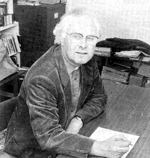
The picture shows
Derek Chapman in the Manse
which was then situated on Crane Drive.
|
For
the period 1945 to 1947 when the Circuit had arranged to have two ordained
ministers, Mrs Flemington offered "Lystra" at a reasonable figure that
could not be refused, though it was two years before the second ordained
minister could be appointed. Pastor Ernest Hill was therefore invited to occupy
"Lystra" whilst the Reverends Frank Brice and Francis Kelley each
served a year as probationer ministers.
Among
the remembered quirks of the ministers the story is told of the Reverend Gordon
Johnson who cycled round the Circuit with a book open on the handlebars,
enabling him to read as he rode; the book-rest was made for him by Mr Evan
Brewer.
THE
CHOIR, ORGAN AND ORGANISTS
Mr
James Thompson, father of Mrs Gwen Reeks, was Choirmaster until 1945 when Mr
Herbert Baker took over owing to Mr Thompson's ill-health. Mrs Dulcie Froud/Sims
remembers Mr Thompson sitting beside her when she played the organ in 1912 when
she was twelve years old. Mr Fred Fry, who taught Dulcie, was also our organist
(Fred Fry was Rosie Pitman's uncle). Victor Sims and Miss Lily Sims were also on
the rota.
The
hymn boards now in use were presented by Mrs E Crawford in memory of her sister,
Mrs L Bower. The original organ was behind the pulpit when Mrs Gwen Reeks was
organist. This organ, costing £200 was bought from Wallace Green on June 25,
1936 and Mrs Eric Shearing became organist for nine years.
Several
violinists helped to accompany the hymns, these being Mr Joe Shearing, Mr Ewart
Goodfellow, Mr Thompson and Mrs Gwen Reek when not playing the organ herself.
Mrs
Daphne Shearing, Mrs Brenda Morey and Mr Douglas Thorne each gave faithful
service as organists over a period of thirty to forty years. Mrs Ruth Thorne, Mr
Fred Bailey, Mrs Mary Wareham and Mrs Paddy Reeks were also on the organ rota,
and were joined in more recent days by Mr Cliff Jones and Mrs Olwen Webb.
Mrs
Rosie Pitman joined the rota in 1954 and was also temporarily put in charge of
the choir. She was appointed official organist in 1980 and Mrs Jean Ewing was
appointed to conduct the choir in 1982.
THE
PEOPLE
The
earliest recorded baptisms at Verwood were in 1903, but in those days the
Minister often carried a register around with him and on occasions Local
Preachers conducted baptisms, which may account for one which took place at
Remedy Oak. Possibly the first baptism in the new building was of Mildred Emma
Brewer on November 7, 1909, the daughter of Fred Brewer; then on November 28,
Kathleen Thurza Irene White was baptised.
When
the present site was conveyed to the Trustees in 1908 there were a number of
names of men whose descendants still serve in the Church or the Circuit. There
were twenty of them who signed the document with the Reverend Toft Walker Cook,
the Superintendent Minister who lived in Wimborne. Of that twenty, three were
farmers, three were brick manufacturers and three were brick makers; there were
two bootmakers, a brick burner, a potter, a schoolmaster, a labourer, a grocer,
a gardener, a wheelwright, a florist and a builder. This gives a picture of the
social background of the area at the beginning of this century in contrast to a
modern count of members of the Church Council (who are now the governing
trustees). In 1984 there were thirteen men of whom seven were retired and seven
ladies without gainful employment. Those in, or who were in, gainful employment
consist of three teachers, one lecturer, two in insurance, two in computers, one
engineer, one clerk, one carpenter, one farmer, one solicitor, one sales
representative and a post office executive.
A
Trust resolution records the death of Sidney Hopkins, killed in France on
September 7, 1917, with appreciation of his valued services to the Wesleyan
Methodist Church. "The deceased brother was untiring in his effort to do
all it was possible for him to do in connection with the building of the new
Church and premises".
Relations
between the Parish Church and Methodism were not always as cordial as they are
to-day and the June Quarterly Meeting of 1902 objected to the Education Bill
"now before the House of Commons on four grounds:-
-
Because
it will destroy the Board Schools.
-
Because
it will place the education of children in thousands of parishes in the
hands of the clergy, many of whom are not Protestants.
-
Because
the people will have to pay for schools over which they have no control.
-
Because
the children of non-conformists will be excluded from the teaching
profession in many towns and villages unless they renounce their
non-conformity and become members of the Church of England as by law
established, as is the case at the present time.
They
therefore pray that you will not proceed with the Bill in its present
form."
But
exactly a year later there was a Tea Table resolution urging all Free Church
Parents who had children attending Church Day Schools to claim their privilege,
withdraw their children from Religious Instruction in those schools, "And
this meeting further resolves that this resolution be read from all the pulpits
in this circuit- "Carried Unaimously"
On
January 29, 1923, 5/- (25p) was voted for the "Worn Out Ministers'
Fund". At the same meeting, Methodist Union proposals were discussed and it
was unanimously agreed that the meeting was in favour of the proposals,
"but that the Church was not yet ripe for union" (Methodist Union took
place in 1932). In the following year Mr. Fry was re-elected secretary, Mrs. L.
Sims oraganist and Mr. J. Thompson Choirmaster, but by February 1926 Mr.
Thompson had resigned. However, by 1928 he had been asked to become Choirmaster
again.
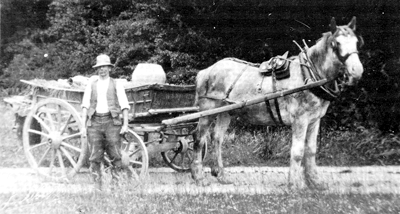 Because
the occupations of many Verwood people were concerned with pottery, the making
of besoms and market gardening, the village could not absorb all these products,
so there grew up a few men who, with horse and cart, took the village products
to the surrounding towns and sold them there. They were called 'higglers'. One
of these was Mr Frederick Brewer, a devoted officer in this Church and Sunday
School. The Photgraph shows one of Verwood's higlers' distibuting Verwood
Pottery. Because
the occupations of many Verwood people were concerned with pottery, the making
of besoms and market gardening, the village could not absorb all these products,
so there grew up a few men who, with horse and cart, took the village products
to the surrounding towns and sold them there. They were called 'higglers'. One
of these was Mr Frederick Brewer, a devoted officer in this Church and Sunday
School. The Photgraph shows one of Verwood's higlers' distibuting Verwood
Pottery.
A
remembered Sunday School Superintendent was Mr. Charles Hibbard, a white-bearded
cobbler, who worked in his cottage on Dewlands Common. He used a hymn book as an
implement of correction as well as an aid to worship. But he was a great example
of consistency as, with only a pair of wooden crutches and one good leg, he
never missed a Sunday.
The
earlier 1920's had already seen the end of the Sunday School Boys' Band, which
helped to serve as a nursery for the Verwood Prize Band. Mr Fred Fry, a potter,
a preacher and Sunday School Teacher had taught and led the Band for some years
and many will remember the set of musical flower pots which he made and played.
His connection with the Band ceased when he entered the Congregational Ministry.
Is
it true that we no longer breed characters like this?
The
Youth Music Group was formed around 1980 after a visit to "Youth Makes
Music" at Bristol. Other Churches were found to have music groups, so it
was decided we must have one in Verwood. Originally six met under the leadership
of Mrs Jean Wadge. The numbers rose to twenty-two and have now settled down to
about a dozen regulars.
On
several occasions they have assisted at worship in Verwood and at several places
in the Salisbury Circuit. They have conducted worship on a visit to Torquay and
now say they will welcome anybody who can play any instrument or sing.
|